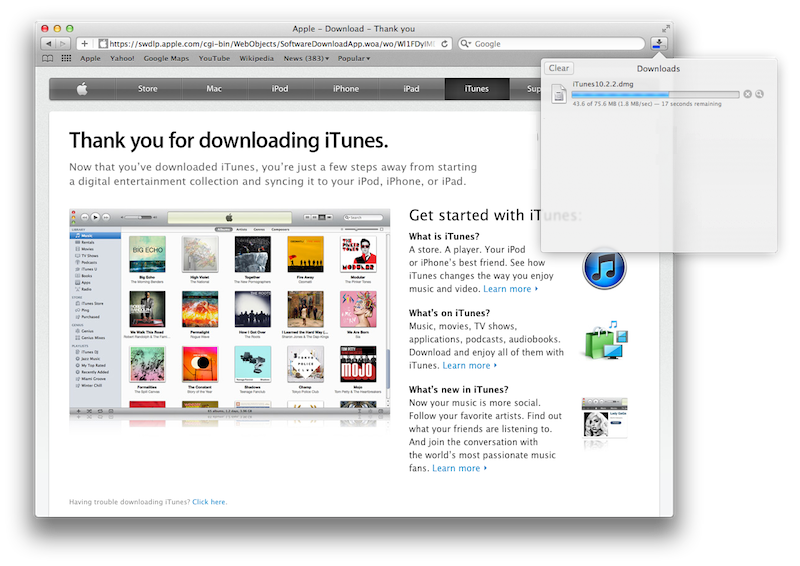
Oh, right: Microsoft did it first, in IE 7, over two years ago ( Figure). It's unclear why a simple grid of Web site previews wouldn't be just as useful, and more in keeping with the Web browser aesthetic. But it's pointlessly visual in a tool that, by nature, is used to find information online. But these people are missing the point (what else is new?): Top Sites' curved, TV-like display would look wonderful on, well, a TV.

Top SitesĪpple fanatics-you know, those idiots who would buy anything with an Apple logo on it-will get all giddy and clap like little girls at a Hannah Montana concert when they see Top Sites, the new default Safari 4 home page. This is a solution in search of a problem. On today's high-res displays, it just doesn't take up that much space anyway. The problem is that the solution it arrived at offers too little value and too much cluttering. Overall, I appreciate what Apple is trying to do here. It looks horrible regardless of what's behind it: A solid color, a desktop background photo, or other windows.

And because the title bar in Safari can be split up into multiple tabs, each with their own little UI controls and text, the title bar area gets very messy, very quickly. The problem is that that glass title bars allow stuff behind Safari to peak through. native) title bar, so the tab row didn't really add to the height of the UI.Īpple also claims that the new Tabs on Top reduces clutter, but the truth is, on Vista and 7, it looks horrible and cluttered. But it only saves space because Safari now uses a native-like title bar: In previous versions of the browser on Windows, there was no true (i.e. Safari's new tabs look ugly no matter how many there are.Īpple claims that moving the tabs to the title bar saves space. This functionality has several consequences, most of which are bad, especially in Windows Vista and 7 where the title bar is transparent glass. But in Safari, tabs are integrated into the title bar area. Most browsers dedicate a row somewhere between the top of the browser window and the page rendering area for tabs. Tabs on TopĪpple's worst decision in this browser is the way it handles tabs. Now, in Safari 4, text is very readable and more akin to what we see in Mozilla Firefox or Internet Explorer. In previous versions of Safari, the browser render text in a bizarre, overly saturated, high contrast fashion that was almost unbearable to look at. While I appreciate any move towards native Windows controls-you know, God forbid, the thing does run in Windows after all-Apple's use of standard Windows font rendering, is perhaps, the browser's most appealing concession to the dominant computing platform. Just tap Alt to see the menu, or you can enable it for good if you'd like. And I will discuss the browser's most horrible user experience miscarriage, its "tabs on top" functionality, in just a bit.Īpple is hiding the Safari menu bar by default, a curiously IE-like move that hides some needed functionality. Apple oddly claims that the Safari 4 title bar and toolbar are native as well, but that's clearly not the case. This time around, Safari utilizes native Windows-style window borders and semi-native window control buttons (Minimize, Maximize/Restore, and Close) on both Windows XP and Vista (and 7). Native Windows look and feelĪpple says that Safari 4 looks more like a Windows application than its predecessors, and while that's certainly true enough, the bar was pretty low. Safari 4 shares some DNA, and some user interface elements, with Google Chrome. (Previous versions looked like an OS X app.) It's "the world's fastest, most efficient, and most innovative" browser, according to the humble folks in Cupertino, and they're even touting its "new Windows-native look," which, as anyone who's used the browser will tell you, is long overdue. Of course, Apple being Apple, they are promoting Safari 4 as if it were the second coming. Safari 4, like its predecessors, is just a horrible Windows application. I just wish Apple could get the basics right on Windows. And that's too bad, because the underlying Web rendering technology utilized by Safari-WebKit-has a better than average chance of becoming the technology layer through which most of us access the Web and cloud-based services of the future. But as an Apple product, it's also uniquely unsuitable for Windows users. As an Apple product, it's immediately interesting of course. They're back this week with a beta version of their upcoming Safari 4 browser, which appears to be Google Chrome with a few UI changes. Well, kudos to Apple for keeping up the good fight.

It's been almost two years since I've looked at Apple's Safari browser in any official capacity (see my overview of Safari 3), and for good reason: Safari simply isn't a good option for Windows users.


 0 kommentar(er)
0 kommentar(er)
